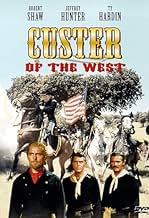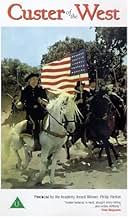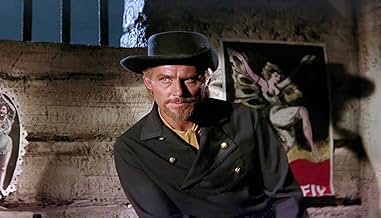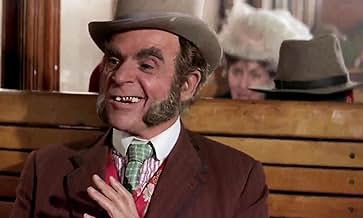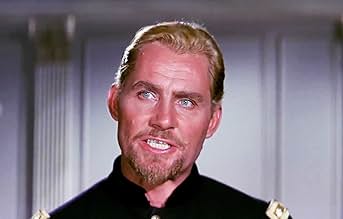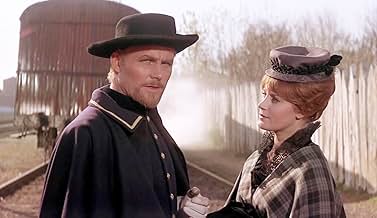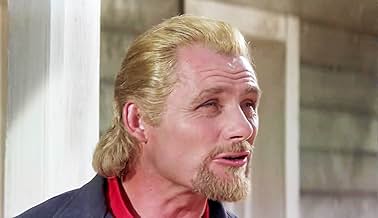IMDb RATING
5.8/10
1.7K
YOUR RATING
George Armstrong Custer's love of the heroic traditions of the Calvary and his distaste with the coming of industrialization leads him to his destiny at the Little Big Horn.George Armstrong Custer's love of the heroic traditions of the Calvary and his distaste with the coming of industrialization leads him to his destiny at the Little Big Horn.George Armstrong Custer's love of the heroic traditions of the Calvary and his distaste with the coming of industrialization leads him to his destiny at the Little Big Horn.
- Director
- Writers
- All cast & crew
- Production, box office & more at IMDbPro
Featured reviews
Okay gang, this is a deeply flawed Custer movie. There is no getting away from that. Yet, if you have any interest at all in the Custer legend (notice I said legend - any relationship to real history and this movie is purely coincidental), and want to see a riveting performance by Robert Shaw, complete with an absurd English accent for Custer, this is a must see movie.
Besides the imaginary history, the geographical locations presented for the story exist only in the minds of the screen writer and director. Despite this, I could not get over how much I liked watching Shaw present his interpretation of Custer. For all the weaknesses in the script, Shaw was given some great speeches to make, demonstrating the tragedy of plains Indians. No matter how ugly the near genocide of them as a people and the total genocide of their culture, and there is no excuse for any of it, they were the victims of events that were pre-determined once Europeans set foot on North America. A point perfectly captured in the movie in the confrontation between Custer and an American actor posing as a representative Indian chief.
For myself, the worst part of the movie, which I was enjoying up to this point, was the Last Stand. Who cares whether it was accurate or not. When was the last time Hollywood ever made any movie about any historical event or person that was not clearly fiction in many aspects? What bothered me, was the fact it was done on the cheap. Custer had around 260 men with him, in the movie, he might have about 50. There is just no drama in watching a big action sequence that falls flat because you were not willing to hire more extras.
Still, I guess this movie is one of my guilty pleasures. If you like action movies or Robert Shaw, give it a look.
Besides the imaginary history, the geographical locations presented for the story exist only in the minds of the screen writer and director. Despite this, I could not get over how much I liked watching Shaw present his interpretation of Custer. For all the weaknesses in the script, Shaw was given some great speeches to make, demonstrating the tragedy of plains Indians. No matter how ugly the near genocide of them as a people and the total genocide of their culture, and there is no excuse for any of it, they were the victims of events that were pre-determined once Europeans set foot on North America. A point perfectly captured in the movie in the confrontation between Custer and an American actor posing as a representative Indian chief.
For myself, the worst part of the movie, which I was enjoying up to this point, was the Last Stand. Who cares whether it was accurate or not. When was the last time Hollywood ever made any movie about any historical event or person that was not clearly fiction in many aspects? What bothered me, was the fact it was done on the cheap. Custer had around 260 men with him, in the movie, he might have about 50. There is just no drama in watching a big action sequence that falls flat because you were not willing to hire more extras.
Still, I guess this movie is one of my guilty pleasures. If you like action movies or Robert Shaw, give it a look.
This is actually a sad movie. I will not mention the end for fear of including a "spoiler", but also I cannot imagine that most American viewers would not already know how it ends.
Though I live overseas now I grew up in the United States in the 1960s (in fact, I still retain my U.S. citizenship). Some of the lines in this 1967 movie are, in fact, anachronisms (they were not in the language in the 1860s or 1870s when this movie was set). The phrase that one U.S. soldier was worth (in combat) 10 Indians was a takeoff on the phrase used at that time in the Vietnam War concerning the kill ratio. Also, the term that General Sheridan used, "Bleeding hearts" comes from the 1960s; not the 1860s. The director of this movie was obviously comparing the moral problems we felt with Vietnam with the same problems the U.S. felt during the Indian Wars a century before. I did not know, of course, any Indian War veterans, but I did know two good men who went to Vietnam and did not come back alive.
Also tearful is the real life love you detect between George and Libby Custer that is portrayed by the real life married couple of Robert Shaw and Mary Ure. Six children between them. She died about ten years later from an accidental overdose of alcohol mixed with sleeping pills. He was so heartbroken that he died a few years later literally of a broken heart.
It is still a magnificent film. The western scenes are indigenous to that part of the United States that it is actually a shock to find out they were filmed not in South Dakota, California, Nevada, Kansas,etc. but rather in Spain!!
Though I live overseas now I grew up in the United States in the 1960s (in fact, I still retain my U.S. citizenship). Some of the lines in this 1967 movie are, in fact, anachronisms (they were not in the language in the 1860s or 1870s when this movie was set). The phrase that one U.S. soldier was worth (in combat) 10 Indians was a takeoff on the phrase used at that time in the Vietnam War concerning the kill ratio. Also, the term that General Sheridan used, "Bleeding hearts" comes from the 1960s; not the 1860s. The director of this movie was obviously comparing the moral problems we felt with Vietnam with the same problems the U.S. felt during the Indian Wars a century before. I did not know, of course, any Indian War veterans, but I did know two good men who went to Vietnam and did not come back alive.
Also tearful is the real life love you detect between George and Libby Custer that is portrayed by the real life married couple of Robert Shaw and Mary Ure. Six children between them. She died about ten years later from an accidental overdose of alcohol mixed with sleeping pills. He was so heartbroken that he died a few years later literally of a broken heart.
It is still a magnificent film. The western scenes are indigenous to that part of the United States that it is actually a shock to find out they were filmed not in South Dakota, California, Nevada, Kansas,etc. but rather in Spain!!
RELEASED IN 1967 and directed by Robert Siodmak, "Custer of the West" is a French/Spanish/American production starring Robert Shaw as the titular hero who becomes the youngest general in the Civil War at 23 and then goes on to fight in the Indian Wars of the northern plains, eventually dying at the Battle of Little Bighorn at the age of 36. Mary Ure plays Custer's wife while Ty Hardin and Jeffrey Hunter play his subordinates Major Reno and Capt. Benteen. Lawrence Tierney is on hand as Gen. Sheridan.
"Custer of the West" both stresses the mistreatment of the plain's Indians by the U.S. and portrays Custer as a tragic American hero who was a puppet of government policy. The film is usually lambasted for its inaccuracies, particularly its depiction of the closing battle. For instance, in real-life Custer's soldiers surprised the Native encampment, they didn't ride up and dialogue with the waiting Indians; moreover, the battle was a chaotic one, moving toward Last Stand Hill. Yet it's not like previous films were any more accurate, e.g. "They Died with Their Boots On" (1941), but audiences apparently demanded more accuracy by the late 60s.
Regardless, the gist of events is true: Reno and Benteen were real-life subordinate officers at odds with Custer and reportedly failed him on the day of battle, although they supposedly had justified cause. If I were Benteen, I would've probably done what he did in the face of Custer's glory-hound rashness and a formidable foe: Dig in, face the enemy, and survive to fight another day. In any case, if you want historical accuracy (to a point) see "Son of the Morning Star" (1991).
The main problem I have with this movie are the Spanish locations substituting for Virginia, the Dakotas and Montana. Fortunately, the creators at least tried to find a setting with trees for Virginia and some of the locations they used for Dakota/Montana occasionally work (just occasionally). But there's a long desert sequence when nothing of the sort exists in the region. You'd have to go far south to New Mexico/Arizona or way further west to eastern Washington to find such deserts. Yet it could be argued that the desert sequence is substituting for the Badlands of the Western Dakotas, which is certainly desert-like.
If you can ignore the disingenuous topographies, there's a lot to appreciate in "Custer of the West." But the film's overlong and bogged down by tedious or useless sequences, like the capture/imprisonment of Sgt. Mulligan (Robert Ryan). But there are some gems, like when Dull Knife (Kieron Moore) pays Custer a visit at the fort (which in real life didn't have a timber stockade). Custer bluntly conveys to the Chief the simple (awful) truth about conquerors and those they conquer: "The problem is precisely the same as when you Cheyenne decided to take another tribe's hunting ground. You didn't ask them about their rights. You didn't care if they had been there a thousand years. You just had more men and more horses. You destroyed them in battle. You took what you wanted and, right or wrong, for better or worse, that is the way things seem to get done. That's history."
FYI: Deviating from the original script, Robert Shaw made the character of Custer over to suit himself, turning him into a "sadist of Shakespearean depth." He also directed the battle scenes with Siodmak staging everything else.
THE MOVIE RUNS 2 hours 21 minutes and was mostly shot 30 miles from Madrid, Spain, except for the Battle of Little Bighorn which was filmed in Costa del Sol near Almira. WRITERS: Bernard Gordon and Julian Zimet with additional work by Shaw.
GRADE: C
"Custer of the West" both stresses the mistreatment of the plain's Indians by the U.S. and portrays Custer as a tragic American hero who was a puppet of government policy. The film is usually lambasted for its inaccuracies, particularly its depiction of the closing battle. For instance, in real-life Custer's soldiers surprised the Native encampment, they didn't ride up and dialogue with the waiting Indians; moreover, the battle was a chaotic one, moving toward Last Stand Hill. Yet it's not like previous films were any more accurate, e.g. "They Died with Their Boots On" (1941), but audiences apparently demanded more accuracy by the late 60s.
Regardless, the gist of events is true: Reno and Benteen were real-life subordinate officers at odds with Custer and reportedly failed him on the day of battle, although they supposedly had justified cause. If I were Benteen, I would've probably done what he did in the face of Custer's glory-hound rashness and a formidable foe: Dig in, face the enemy, and survive to fight another day. In any case, if you want historical accuracy (to a point) see "Son of the Morning Star" (1991).
The main problem I have with this movie are the Spanish locations substituting for Virginia, the Dakotas and Montana. Fortunately, the creators at least tried to find a setting with trees for Virginia and some of the locations they used for Dakota/Montana occasionally work (just occasionally). But there's a long desert sequence when nothing of the sort exists in the region. You'd have to go far south to New Mexico/Arizona or way further west to eastern Washington to find such deserts. Yet it could be argued that the desert sequence is substituting for the Badlands of the Western Dakotas, which is certainly desert-like.
If you can ignore the disingenuous topographies, there's a lot to appreciate in "Custer of the West." But the film's overlong and bogged down by tedious or useless sequences, like the capture/imprisonment of Sgt. Mulligan (Robert Ryan). But there are some gems, like when Dull Knife (Kieron Moore) pays Custer a visit at the fort (which in real life didn't have a timber stockade). Custer bluntly conveys to the Chief the simple (awful) truth about conquerors and those they conquer: "The problem is precisely the same as when you Cheyenne decided to take another tribe's hunting ground. You didn't ask them about their rights. You didn't care if they had been there a thousand years. You just had more men and more horses. You destroyed them in battle. You took what you wanted and, right or wrong, for better or worse, that is the way things seem to get done. That's history."
FYI: Deviating from the original script, Robert Shaw made the character of Custer over to suit himself, turning him into a "sadist of Shakespearean depth." He also directed the battle scenes with Siodmak staging everything else.
THE MOVIE RUNS 2 hours 21 minutes and was mostly shot 30 miles from Madrid, Spain, except for the Battle of Little Bighorn which was filmed in Costa del Sol near Almira. WRITERS: Bernard Gordon and Julian Zimet with additional work by Shaw.
GRADE: C
I'll make this short and sweet, on second thought, I'll try to! For anyone who has studied history and even scanned a chapter about Custer, could tell that this story line seemed to be made-up as it went along. I have watched this movie only once, and that was more than enough. I understand Hollywoods need to add to, or change charactors or situations to sell a movie. BUT, when they feel the need to give Gen. Armstrong Custer an english accent, Wow!!! Flags went up as soon as he spoke. Ok, ok, overlook that. The thing that gets me the most is the way this movie seems to change the man, to what (I Guess) they wish he was. That too can be overlooked. But, when you change history around to such extremes as, lets pick on the Battle of the Little Big Horn. The way it is acted out is not only corny, but totally oblivious to the truth. The movie has Custer confronting the Indians right before the battle, (According to both versions{The Indians & The Whites} of history, HE DIDN'T).In the movie he didn't flee up the hill(as he did inreal life), away from the village, then finally dismount at almost the top of a hill, surrounded, there to die, and where some mutilations took place.Custer, being the last man standing(YEA, RIGHT!), gets an offer from the chief to let him go, (There was no, I repeat NO SUCH OFFER!) as there was in the movie. Enough you say, there had to be some good. Robert Ryan, in his, much to small a part, was, as usual top notch. However, the story being sooo far fetched ruined it for me. MY RATING: For the valid attept to make a movie,I give 1 Star, Add 1 Star for some decent Charactor Actors, & add 2 for Robert Ryans far too few moments. But, I have to subtract 1 just becaus they thought we wouldn't notice the english accent. 3 Out of 10 STARS
An unusual cast was gathered for this tribute to a western hero whose accomplishments in real life are dubious to say the least. Scholars and history buffs can argue the facts and merits of General George Armstrong Custer. This review pertains to the actual film. It begins with a very odd credits sequence in which Shaw and Ure are billed as starring, then the title comes up and then zilch. No other actors or crew are mentioned. Then four years of Civil War battles are represented by years popping up on screen as Shaw tears across what looks like the same field on horseback while cannons blast continuously. So much for establishing his war record...from this he basically outran some cannons for four years straight! He gets new orders from superior Tierney (brandishing a very contemporary accent that's just as jarring as Shaw's own British-tinged one) and is soon headed out west to rid the land of Indians. First, he is reunited with his wife (in real life as well) Ure in a series of brief, strange vignettes as they travel to his new post. Once there, he is greeted by a haggard-looking Hunter (who would be dead in real life within a year) and fit, yummy Hardin (miscast as a drunkard.) In fact, the film ties with "Ride the Wild Surf" as having the most cast members change their usual looks for their roles. Brown-haired Shaw goes blonde, blonde Ure goes auburn, Hunter's hair is longer and bushy with fake gray highlights and Hardin's blonde locks are brown and he sports a huge moustache. Ryan, as a soldier who deserts to find gold, pops in long enough to show up everyone else and display what good acting can be. The film details Shaw's struggle to solve the "Indian problem". The government wants rid of them, yet he sees, to an extent, their plight. Unfortunately, the film is so episodic and disjointed in it's scripting that it can't build very much momentum or create a memorable story. Though it is long, the audience never really gets to know the characters very well. A lot of time is spent on rather elaborate set pieces (some of which are impressive) like a wagon wreck, a ride down a log flume, an attack on a train and the final stand off. Another chunk of time is wasted in ludicrous Washington scenes which include a cheaply done speech by Shaw before Congress and a (deliberately?) horrible stage show. (Shaw wrote the lyrics of one of the songs himself!) One of the best sequences involves Shaw's attempt to show his men who is boss through a rigorous training exercise in which all but one fall down completely. One major asset is the wide-screen photography which shows off some nice scenery and a few inventive compositions. The finale, with its horde of Indian warriors, is surely best seen in the letterboxed format. It's surprising to see such an old fashioned us (Cavalry) vs them (Indians) approach in a 1968 film, four years after "Cheyenne Autumn". Aspirations to tell a complex version of the tale are done in by sketchy characterizations and poor performances by some of the supporting cast (including Moore as the primary Indian chief.) The score is distracting and often overly loud. The acting is uneven. The editing is profanely awkward. In the end, the audience has not been enlightened to any degree and has watched a two hour and twenty minute film in which Hardin didn't even take his shirt off once!
Did you know
- TriviaSome sources have suggested that this was originally to be directed by Akira Kurosawa, but he pulled out. However, this is massively unlikely, given the production history of the film. The more likely explanation is that Kurosawa was approached about directing a different film project on the same subject, "The Day Custer Fell", which was in the works at 20th Century Fox for several years, and for which several Japanese actors famous for working with Kurosawa were approached to play the leading Native American roles. Fred Zinnemann was eventually attached to this project, but it was canceled by Fox because of its ever-escalating budget. "Custer Of The West" was put together very quickly (and made rather cheaply) once this occurred.
- GoofsThe troops of the 7th Cavalry are shown with 1873 Winchester rifles, which were in wide use by 1876, but not by the US Army. Custer's men were armed, as all troopers who did not purchase their own rifles were, with the 1873 Springfield Trapdoor carbine, a single-shot weapon. Had Custer's men been armed with the Winchester, it is possible, though unlikely, that they could have held out until relieved.
- Quotes
Gen. Philip Sheridan: You know, you could become a living legend... or get yourself killed. Dead men make better legends.
- Alternate versions35mm prints released in both complete and shortened versions. Some shortened versions were titled "A Good Day for Fighting".
- ConnectionsFeatured in I Am Not Your Negro (2016)
- How long is Custer of the West?Powered by Alexa
Details
Box office
- Budget
- $4,000,000 (estimated)
- Runtime
- 2h 20m(140 min)
Contribute to this page
Suggest an edit or add missing content

